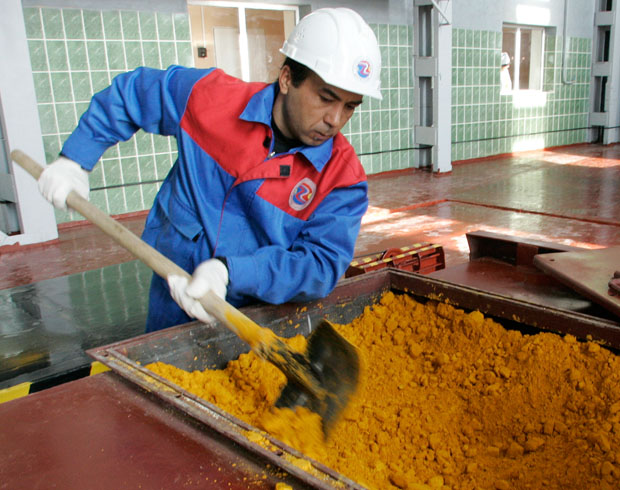
Kazatomprom IPO to Test-Drive Kazakhstan’s Privatization Plan
Publication: Eurasia Daily Monitor Volume: 15 Issue: 159
By:

Kazakhstan’s national uranium company Kazatomprom said, on October 15, that it was ready to go public by selling a portion of its issued shares on the London Stock Exchange and on the trading platform of the Astana International Financial Center (AIFC). The AIFC was officially launched without much fanfare in January 2018. It was later inaugurated by Kazakhstani President Nursultan Nazarbayev on the eve of his birthday and the 20th anniversary of the founding of his country’s current capital, Astana, both of which fall on July 6. The Astana International Exchange has a few registered members but no shares are currently traded, with all trading in equity and bonds taking place on the Almaty-based Kazakhstan Stock Exchange, instead. In 2015, Nazarbayev signed into law a special piece of legislation granting AIFC residents long-term tax breaks, hassle-free work permits and other perks. The brand-new financial center has a court of arbitration and a court of appeal, each staffed with Western-born judges and using English common law in what is the first extraterritorial application of foreign laws in Kazakhstan (Kursiv.kz, October 15; Mir24.tv, July 5; Sputniknews.kz, January 1).
If Kazatomprom becomes a public company, it will be only the second major uranium miner in the world, after Canada’s Cameco, to obtain such a status. Kazakhstan’s sovereign wealth fund Samruk Kazyna, whose assets account for about 60 percent of national GDP, intends to dispose of up to a quarter of all shares outstanding (issued shares minus those held in treasury). Regardless of how many shares are eventually subscribed, it will remain the majority shareholder and will continue to exert effective control over company operations. According to further announcements made on October 31, Kazatomprom’s management values the whole company at between $3 billion and $4 billion. Initially, it plans to sell not more than 15 percent of the shares offered under the IPO to outside investors, including at least one fifth within the AIFC. The trading of global depository receipts (GDR) in London should commence on November 13, to be followed by the start of trading in GDRs and common stock in Kazakhstan several days later (Kazatomprom.kz, Informburo.kz, October 31; Kapital.kz, October 24).
The global uranium sector is a highly concentrated industry, and Kazatomprom just happens to be the world’s largest producer of uranium, a strategic metal used for both civilian and military purposes. Last year, its output from wholly and jointly owned enterprises reached 12,100 tons, equivalent to 20 percent of the world total. Unlike most other producers that rely on good relations with foreign governments for continued access to their reserves, Kazatomprom has its entire resource base of approximately 300,000 tons located in Kazakhstan alone. In 2017, it had total sales of $907 million, down from $1.1 billion the year before, although its net profit rose year-on-year from approximately $300.8 million to some $375.2 million. Kazatomprom CEO Galymzhan Pirmatov confirmed in mid-October that his firm would pursue a transition from volume-based to value-based, market-driven production as a way of enhancing shareholder value. In December 2017, the company made public its decision to slash output by a fifth over a three-year period amid global uranium glut weighing heavily on profitability (Kazatomprom.kz, October 31, 2018; Total.kz, October 15, 2018; abctv.kz, December 21, 2017).
The partial privatization of Kazatomprom is part and parcel of a major state asset sale program that started taking shape during 2015. The Kazakhstani government had previously unsuccessfully tried to attract ordinary citizens into public markets through the so-called People’s IPO initiative (see EDM, March 3, 2011). The state-owned oil transportation company KazTransOil, a subsidiary of the national oil and gas operator KazMunayGas, became the first participant in late 2012 by selling a 10 percent stake. However, the People’s IPO had been definitively terminated by 2016 because of limited popularity with retail investors and steady losses incurred by the courageous few. In early 2018, National Economy Minister Timur Suleimenov reiterated plans to sell government-owned stakes in both Kazatomprom and the national air carrier, Air Astana, by 2019. No updates have been available of late, though, with regard to either Air Astana or other flagship companies slated for partial privatization, such as Samruk Energy, Kazakh Railways or Kazakhtelecom (Abctv.kz, July 5, 2018; Zakon.kz, March 26, 2018; Forbes Kazakhstan, November 15, 2015).
To most market watchers, the overdue privatization saga is a purely economic matter reflecting the Kazakhstani authorities’ desire to lessen the financial burden of clunky industrial giants while replenishing state coffers with overseas investors’ money. Besides the usual number crunching and fine-tuning of estimates of expected returns, foreign buyers are obviously attentive to domestic political developments. Recent reports of Royal Dutch Shell’s refusal to acquire a minority stake in KazMunayGas ahead of its own IPO currently scheduled for 2020—based on an analysis of the presidential son-in-law’s informal influence over the company—were a cold shower for the Nazarbayev administration. Another factor to take into account, however, is neighboring Russia, which has its own powerful uranium industry. Historically, Russia has sought to prevent Kazakhstan from reaching beyond the mere extraction of uranium from the ground. A Kazatomprom operating under the constant scrutiny of markets would likely want to attain a higher valuation through diversification. It is unclear how favorably Rosatom will view such a strategy and to what lengths it may go to crush it in the initial stages (Regnum, October 9).



